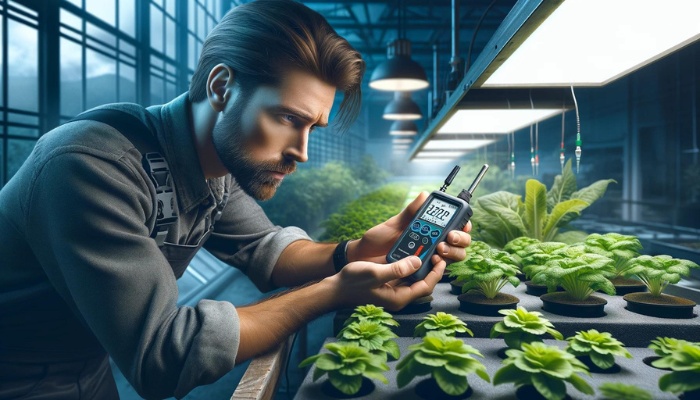To measure electrical conductivity (EC) in hydroponics, you’ll need a calibrated EC meter tailored for hydroponic use. Start with a clean container, and fill it with your nutrient solution.
The solution’s temperature should be between 65°F and 75°F. For optimal results, adjust its pH to between 5.5 and 6.5.
Immerse the EC meter’s probe into the solution until it stabilizes for an accurate reading. Monthly calibration of your meter with the correct calibration solution is important for maintaining accuracy.
Understanding EC in Hydroponics
It’s important to grasp what Electrical Conductivity (EC) means in the context of hydroponics and how it directly impacts plant growth.
EC signifies the total amount of soluble salts in your hydroponic solution, essentially reflecting the nutrient concentration available to your plants.
Understanding EC is pivotal for maintaining optimal plant health as it influences the plant’s ability to absorb water and nutrients efficiently.
High EC levels can lead to nutrient burn, stressing your plants and potentially stunting their growth.
Conversely, low EC levels might indicate that your plants aren’t receiving enough nutrients, making them vulnerable to diseases and underdevelopment. It’s a delicate balance, and you’ve got to get it right for your plants to thrive.
Adjusting the EC levels in your hydroponic system is about more than ensuring your plants get enough food; it’s about providing them with a balanced diet.
Your goal is to find the sweet spot where your plants have access to just the right amount of nutrients—not too sparse, not too rich.
Choosing the Right EC Meter
Selecting the appropriate EC meter allows you to accurately monitor the nutrient concentration in your hydroponic solution.
When you’re in the market for an EC meter, your focus should be on two key features: meter calibration and water resistance. These attributes significantly impact the precision and durability of the device in a hydroponic environment.
Meter calibration ensures your readings are accurate. Over time, the accuracy of EC meters can drift, leading to misleading data about your nutrient solution.
Opt for a meter that offers easy, straightforward calibration processes. Some advanced meters even alert you when it’s time for recalibration, maintaining the accuracy of your measurements without guesswork.
Water resistance is another critical factor. Given the nature of hydroponics, your EC meter is likely to come into contact with water frequently.
A water-resistant or waterproof design prevents damage to the internal components of the meter, extending its lifespan and ensuring consistent performance.
Preparing Your Nutrient Solution
To prepare your nutrient solution effectively, you’ll need to first ensure accurate measurements of each component. It’s crucial to start with a clean container and precisely measured amounts of water and nutrients.
This precision ensures that your plants receive the exact nutrients they need for optimal growth.
Next, pay close attention to the water temperature. Temperature affects nutrient uptake and plant metabolism.
Ideally, keep your solution between 65°F and 75°F (18°C to 24°C) to ensure nutrients dissolve properly and are readily available to your plants.
Equally important is adjusting the solution pH. The pH level influences how well plants can absorb nutrients. Most hydroponic systems thrive when the solution pH is maintained between 5.5 and 6.5.
To adjust pH levels, you’ll use pH up or down solutions. Adding these carefully in small increments and testing frequently with a reliable pH meter is essential for maintaining the optimal nutrient environment.
Conducting the EC Measurement
After ensuring your nutrient solution is at the right temperature and pH, it’s time to measure its electrical conductivity (EC) to evaluate nutrient levels accurately.
Before you start, you need to be aware that temperature significantly impacts EC readings. As the temperature increases, so does the mobility of ions in the solution, leading to higher EC values.
Most modern EC meters automatically compensate for temperature variations, but it’s essential to ensure your meter is set correctly for the solution’s current temperature.
Calibration frequency is another key aspect. Regular calibration of your EC meter ensures the accuracy of your measurements.
Manufacturers typically recommend calibrating your device at least once every month, especially if you use it frequently. For the most precise results, always use the calibration solution that matches your meter’s specifications.
To conduct the EC measurement, simply immerse the meter’s probe into your nutrient solution. Wait for the reading to stabilize before recording the value.
This step ensures an accurate assessment of the nutrient levels present in your solution, enabling you to make informed decisions about maintaining your hydroponic system.
Adjusting EC Levels Appropriately
Once you’ve determined the electrical conductivity (EC) level of your nutrient solution, it’s essential to adjust it accurately to meet your plants’ specific needs.
Adjusting EC levels is a delicate process, requiring a precise understanding of plant responses to different nutrient concentrations.
If the EC is too high, your plants may experience nutrient burn, leading to stunted growth and poor health. An EC that’s too low won’t provide sufficient nutrients, resulting in undernourished plants.
To start, monitor your plants closely for signs of distress, which can often indicate EC fluctuations.
Yellowing leaves, for example, may suggest nutrient deficiencies, but burnt leaf edges typically point to excess nutrients. These plant responses are critical indicators that it’s time to adjust your EC levels.
Increasing the EC involves adding a more concentrated nutrient solution. Decreasing it requires diluting your mixture with pure water. Changes should be made gradually to allow your plants to adjust without shock.
After each adjustment, wait for at least a day before remeasuring the EC, giving your plants time to respond to the new conditions.

